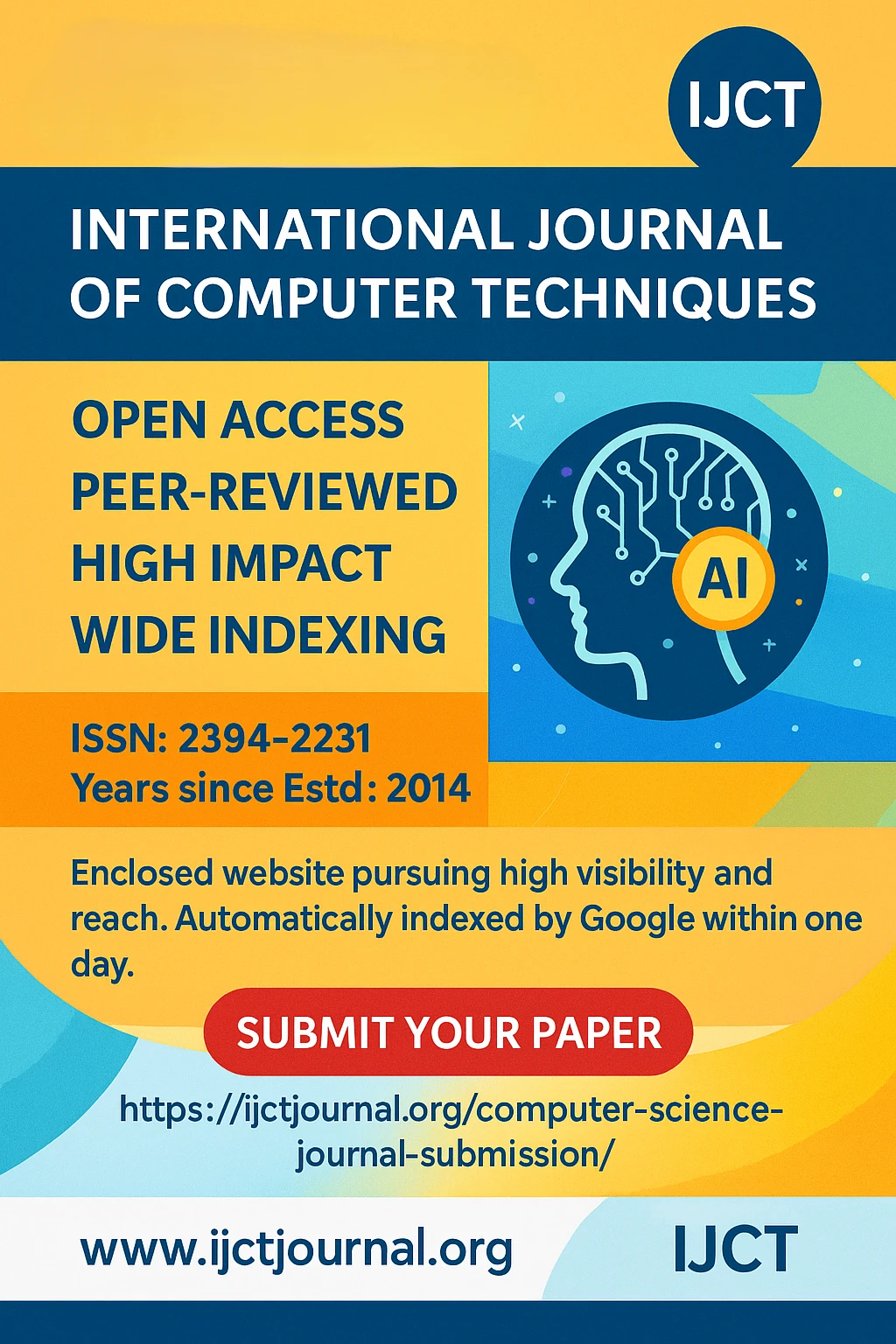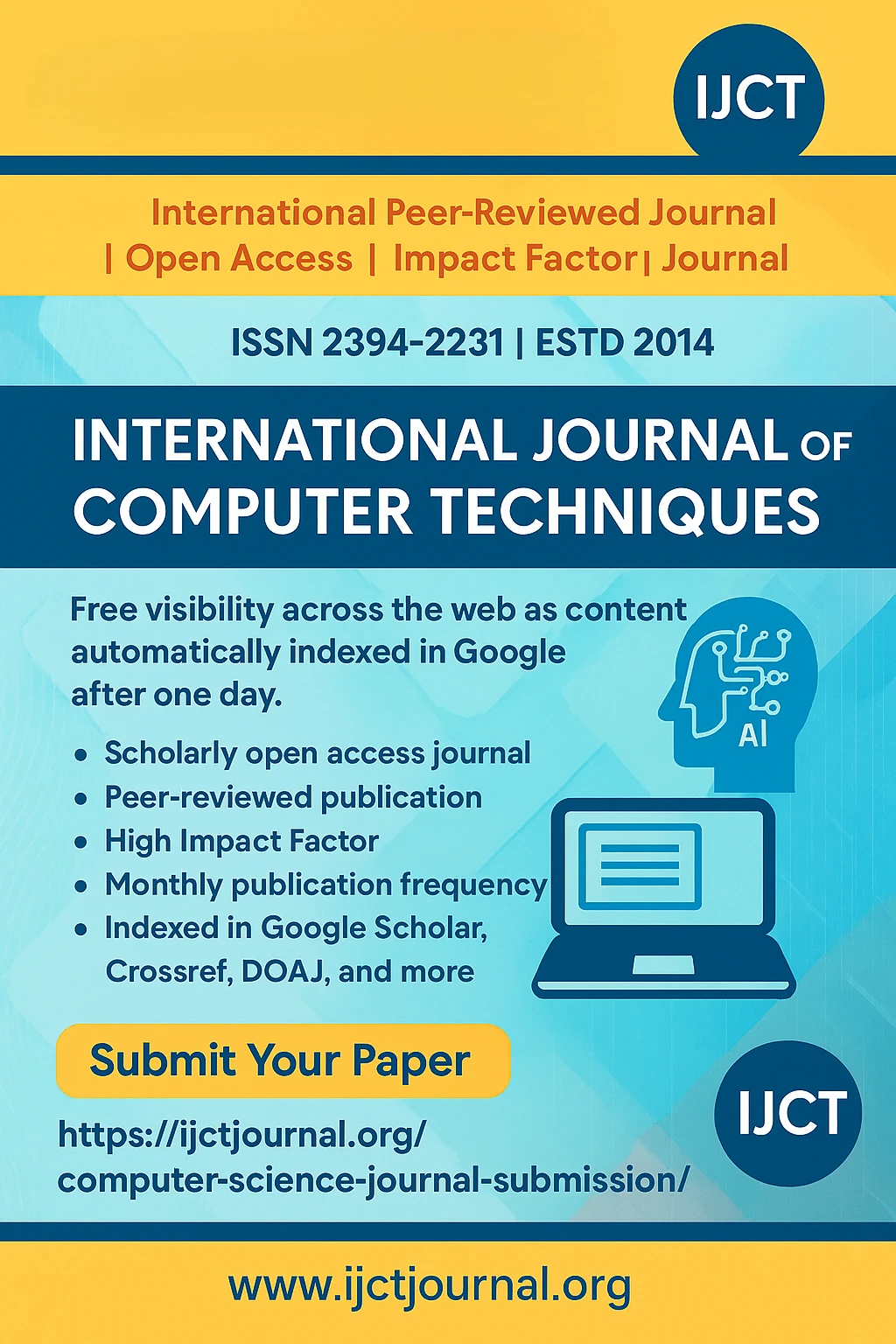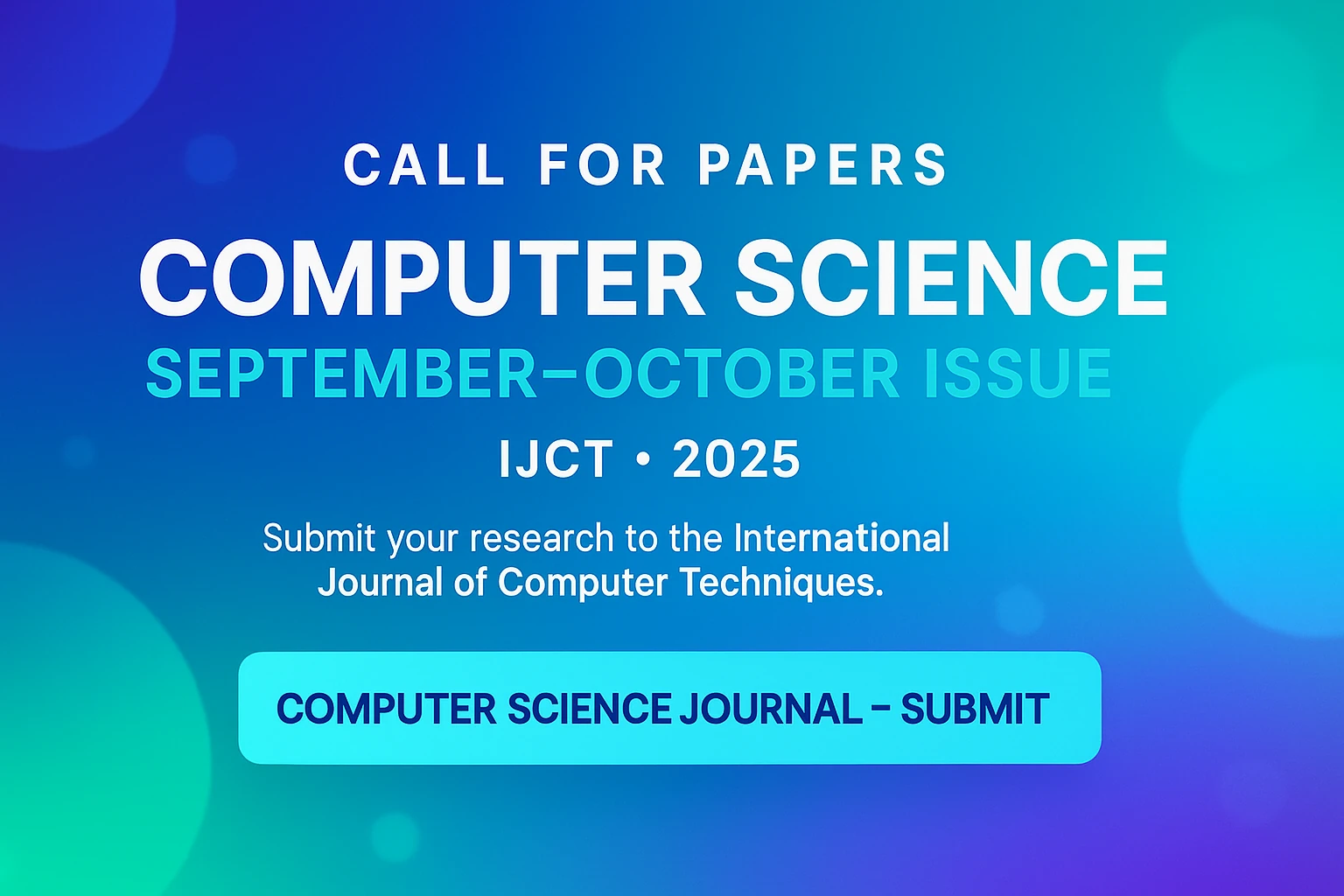
Breast Cancer Classification and Segmentation Using Machine Learning Classifiers and Convolutional Neural Networks – IJCT Volume 12 – Issue 5 | IJCTV12I5P50

International Journal of Computer Techniques
ISSN 2394-2231
Volume 12, Issue 5 | Published: September – October 2025
Author
M. Praveen
Table of Contents
ToggleAbstract
One of the top causes of death in women across the globe is breast cancer and early diagnosis is crucial in enhancing survival. This paper introduces a computer-based diagnostic tool, which uses machine learning classifiers and convolutional neural nets to effectively classify and segment breast cancer. The Proposed system uses preprocessing methods that optimize mammogram images and then detects suspicious areas, feature extraction and classification by algorithms such as Support Vector Machine, Decision Tree, Random Forest, and XGBoost. Ensemble methods such as bagging, boosting and stacking are utilized to improve accuracy and minimize misclassification. A multimodal architecture is created, in which the base classifiers predictions are pooled and improved by artificial neural networks to come up with more reliable results. Besides, the convolutional neural networks are implemented to enhance the feature representation and segmentation performance, thus, more effectively distinguishing between benign and malignant tissues. The system was tested on benchmark datasets, and it can be classified with high accuracy, with the highest results of 96.5% in the case of the Random Forest and 99.3% in the case of XGBoost, and the CNN models increased the reliability of segmentation. The benefit of this hybrid setup is that it enables the interpretability of machine learning classifiers with the strong representation learning of deep networks which decreases false positives and false negatives. The paper identifies the possibility of using intelligent multimodal systems to aid radiologists in early detection and diagnosis of breast cancer, which will eventually help improve patient outcome. Such a framework offers an effective and systematic solution that can be scaled to real-time clinical uses
Keywords
Breast cancer classification, medical image segmentation, machine learning classifiers, convolutional neural networks, ensemble learning, mammogram analysis, computer-aided diagnosis, hybrid diagnostic systemsConclusion
This propsed work presents a multimodal diagnostic system that combines classical classifiers, ensemble learning techniques, and deep neural networks to detect and segment breast cancer. The method proved to be more accurate and robust, in addition to being interpretable, than individual methods, with CNNs allowing accurate localization of lesions and stacked classifiers to improve predictive accuracy. The system integrates classification and segmentation into a single pipeline to deliver clinically relevant results that may be used to aid early and accurate diagnosis. Future research will emphasize testing the framework on larger and more heterogeneous datasets and other imaging modalities to further justify its usefulness in practice in real-life clinical settings.
References
[1] Qasrawi, R., Daraghmeh, O., Qdaih, I., Thwib, S., Polo, S. V., Owienah, H., … & Atari, S. (2024). Hybrid ensemble deep learning model for advancing breast cancer detection and classification in clinical applications. Heliyon, 10(19).
[2] Tschuchnig, M., Gadermayr, M., & Djemal, K. (2025). Hybrid Deep Learning and Handcrafted Feature Fusion for Mammographic Breast Cancer Classification. arXiv preprint arXiv:2507.19843.
[3] Sharafaddini, A. M., Esfahani, K. K., & Mansouri, N. (2025). Deep learning approaches to detect breast cancer: a comprehensive review. Multimedia Tools and Applications, 84(21), 24079-24190.
[4] Al-Hejri, A. M., Sable, A. H., Al-Tam, R. M., Al-Antari, M. A., Alshamrani, S. S., Alshmrany, K. M., & Alatebi, W. (2025). A hybrid explainable federated-based vision transformer framework for breast cancer prediction via risk factors. Scientific Reports, 15(1), 18453.
[5] Lilhore, U. K., Sharma, Y. K., Shukla, B. K., Vadlamudi, M. N., Simaiya, S., Alroobaea, R., … & Baqasah, A. M. (2025). Hybrid convolutional neural network and bi-LSTM model with EfficientNet-B0 for high-accuracy breast cancer detection and classification. Scientific Reports, 15(1), 12082.
[6] Halder, R. K., Lima, M. A., Uddin, M. N., Islam, M. A., & Saha, A. (2025). Integrated feature selection-based stacking ensemble model using optimized hyperparameters to predict breast cancer with smart web application. Clinical eHealth.
[7] Miao, L., Li, Z., & Gao, J. (2025). A multi-model machine learning framework for breast cancer risk stratification using clinical and imaging data. Journal of X-Ray Science and Technology, 33(2), 360-375.
[8] Hoque, R., Das, S., Hoque, M., & Haque, E. (2024). Breast cancer classification using XGBoost. World Journal of Advanced Research and Reviews, 21(2), 1985-1994.
[9] Mustafa, Maral A., Osman Ayhan Erdem, and Esra Söğüt. “Hybrid Optimization and Explainable Deep Learning for Breast Cancer Detection.” Applied Sciences 15.15 (2025): 8448.
[10] Miao, P., & Zou, Y. (2025). Explainable AI-enabled hybrid deep learning architecture for breast cancer detection. Frontiers in Immunology, 16, 1658741.
[11] Nuneti, G., Ch, R. P., & Kumar K, R. (2025). AI-Assisted Breast Cancer Prediction, Classification, and Future Directions: A Narrative Review Involving Histopathological Image Datasets. The Open Public Health Journal, 18(1).
[12] Al-Hejri, A. M., Sable, A. H., Al-Tam, R. M., Al-Antari, M. A., Alshamrani, S. S., Alshmrany, K. M., & Alatebi, W. (2025). A hybrid explainable federated-based vision transformer framework for breast cancer prediction via risk factors. Scientific Reports, 15(1), 18453.
[13] Ahad, M. T., Mustofa, S., Ahmed, F., Emon, Y. R., & Anu, A. D. (2024). A study on Deep Convolutional Neural Networks, Transfer Learning and Ensemble Model for Breast Cancer Detection. arXiv preprint arXiv:2409.06699.
[14] Alharthi, A., Alqurashi, A., Alharbi, T., Alammar, M., Aldosari, N., Bouchekara, H., … & Ayidh, A. A. (2024). The Role of Explainable AI in Revolutionizing Human Health Monitoring: A Review. arXiv preprint arXiv:2409.07347.
[15] Manojee, K. S., & Kannan, A. R. (2025). Patho-Net: enhancing breast cancer classification using deep learning and explainable artificial intelligence. American Journal of Cancer Research, 15(2), 754.
[16] Carriero, A., Groenhoff, L., Vologina, E., Basile, P., & Albera, M. (2024). Deep learning in breast cancer imaging: State of the art and recent advancements in early 2024. Diagnostics, 14(8), 848.
[17] Wang, L. (2024). Mammography with deep learning for breast cancer detection. Frontiers in oncology, 14, 1281922.
[18] Boudouh, S. S., & Bouakkaz, M. (2023). Enhanced breast mass mammography classification approach based on pre-processing and hybridization of transfer learning models. Journal of Cancer Research and Clinical Oncology, 149(16), 14549-14564.
[19] Liao, L., & Aagaard, E. M. (2024). An open codebase for enhancing transparency in deep learning-based breast cancer diagnosis utilizing CBIS-DDSM data. Scientific reports, 14(1), 27318.
[20] Das, H. S., Das, A., Neog, A., Mallik, S., Bora, K., & Zhao, Z. (2023). Breast cancer detection: Shallow convolutional neural network against deep convolutional neural networks based approach. Frontiers in Genetics, 13, 1097207.
[21] Jiang, B., Bao, L., He, S., Chen, X., Jin, Z., & Ye, Y. (2024). Deep learning applications in breast cancer histopathological imaging: diagnosis, treatment, and prognosis. Breast Cancer Research, 26(1), 137.
[22] Singh, T., Jha, S., Bhatt, N., Handa, P., Goel, N., & Indu, S. (2024). Artificial Intelligence in Gastrointestinal Bleeding Analysis for Video Capsule Endoscopy: Insights, Innovations, and Prospects (2008-2023). arXiv preprint arXiv:2409.00639.
[23] Jiangtao, W., Ruhaiyem, N. I. R., & Panpan, F. (2025). A Comprehensive Review of U‐Net and Its Variants: Advances and Applications in Medical Image Segmentation. IET Image Processing, 19(1), e70019.
[24] Dhamotharan, G., Palanisami, D., Mohan, N., & Deivasigamani, V. (2025). A segmentation model for breast cancer images-FAUNet. Biomedical Signal Processing and Control, 110, 108278.
[25] Xu, Z., Rauch, D. E., Mohamed, R. M., Pashapoor, S., Zhou, Z., Panthi, B., … & Ma, J. (2023). Deep learning for fully automatic tumor segmentation on serially acquired dynamic contrast-enhanced MRI images of triple-negative breast cancer. Cancers, 15(19), 4829.
[26] Mannumadam Venugopal, S. (2024). Can Vision Transformers Be the Next State-of-the-Art Model for Oncology Medical Image Analysis?. AI in Precision Oncology, 1(6), 286-305.
[27] Vo, H. Q., Wang, L., Wong, K. K., Ezeana, C. F., Yu, X., Yang, W., … & Wong, S. T. (2024). Frozen large-scale pretrained vision-language models are the effective foundational backbone for multimodal breast cancer prediction. IEEE journal of biomedical and health informatics.
[28] Shukla, S., Rajkumar, S., Sinha, A., Esha, M., Elango, K., & Sampath, V. (2025). Federated learning with differential privacy for breast cancer diagnosis enabling secure data sharing and model integrity. Scientific Reports, 15(1), 13061.
[29] Tzortzis, I. N., Gutierrez-Torre, A., Sykiotis, S., Agulló, F., Bakalos, N., Doulamis, A., … & Berral, J. L. (2025). Towards generalizable Federated Learning in medical imaging: A real-world case study on mammography data. Computational and structural biotechnology journal, 28, 106-117.
[30] Chen, J., Pan, T., Zhu, Z., Liu, L., Zhao, N., Feng, X., … & Zhou, G. (2025). A deep learning-based multimodal medical imaging model for breast cancer screening. Scientific Reports, 15(1), 14696.
Journal Covers
IJCT Important Links
© 2025 International Journal of Computer Techniques (IJCT).












